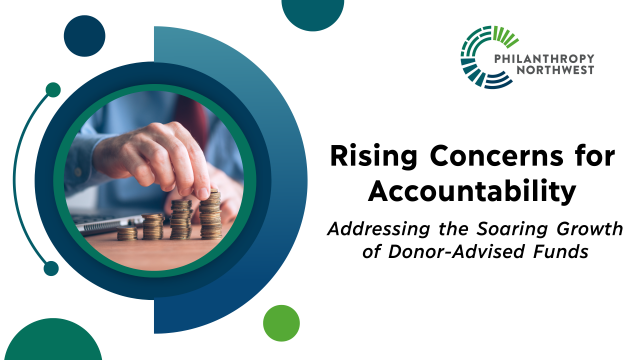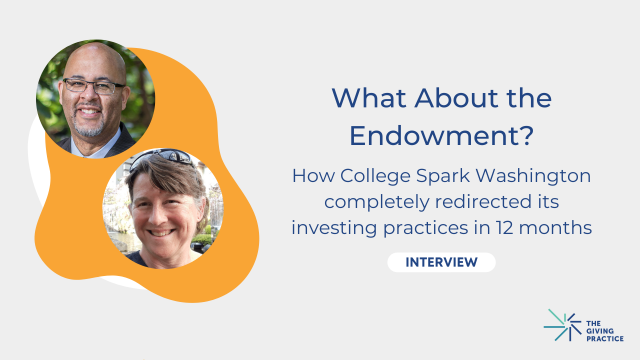Part 1 of a three-part series.
How many of us can open our investment statements and say this:
“Hello, Beautiful Portfolio! We have intentionally designed this portfolio using a decision-making framework that takes into consideration what is most important to us in the world. We have made deliberate decisions. This is a portfolio that is integrated with our values and priorities. Where there are compromises, they have been made with eyes wide open and for reasons we understand. It’s interesting and affirming to open and read this report.”
Or do you open your investment statement and feel like you want to be sick?
Are you a trustee or executive at a foundation that shares our vision of Northwest communities with vibrant, healthy futures that honor our past, our people and our cultures? Have you read the list of companies in which your assets are invested — not the names of the funds or managers, but the actual holdings — and wondered how you can reconcile these names with your mission and values?
You are not alone. In my work as an investment advisor and now as an Impact Investing Catalyst Fellow with Philanthropy Northwest, I have found that a surprising number of institutions and individuals have forced themselves to compartmentalize by separating their values from their investments, their common sense from the money “wisdom” that has been drummed into them by experts, and their desire for integration and authenticity from their need to achieve financial security. They are inadvertently accepting, even embracing, a set of assumptions and practices that are problematic and outdated. Failure to examine and question these assumptions and then deal honestly with the inevitable contradictions and tradeoffs makes it easy to construct walls and barriers between investments and mission, whether organizational or personal or both. The alternative — a Beautiful Portfolio — provides a path to authenticity and honesty in our financial lives.
Knowledge is Power
The first step toward a Beautiful Portfolio is to know and understand what your current investment portfolio contains, how much it costs, what it promises, what it actually delivers and what it says about you. While this may sound simple, it can be daunting because the investment industry tends toward jargon and over-complication. One of my individual advisory clients often jokes that when she is in an investment meeting, the advisor talks the language of finance, but all she hears is “blah, blah, blah.” To her great credit, she has recognized that this form of communication is patronizing and intended to create a relationship based on dependency and even intimidation. This is often easily accomplished in the financial arena because money is a very sensitive subject. Whether we are working on our own investments or those of our organization, we are often shrouded in anxiety and fear that makes us highly vulnerable to expert advice that might involve decisions we don’t understand or don’t like.
Thus, this first step — becoming fully informed and knowledgeable — requires guts and determination. My advice is to keep asking questions until you really understand what is important to understand. We all have different levels of interest and capacity, but whether we are dealing with our personal investments or participating in the financial activities of our organization, we owe it to ourselves to be fully informed—even if we are delegating much of the work. There’s a big difference between delegating because you don’t understand and delegating because you have made an informed decision to do so.
Begin by gathering six types of information from your investment professionals:
- A summary statement of investments showing the names of investment managers and/or mutual funds and ETFs, a description of each type of investment (such as public equity —small cap or short-term bonds), a current market value or estimated value for each item.
- A detailed listing of every security in your portfolio. For each managed portfolio, mutual fund, or ETF, there are underlying holdings such as individual stocks like Apple or bonds like US Treasuries or Seattle municipal bonds. Get a list of each item.
- Financial performance data, including the average annual total rate of return (interest, dividends and capital appreciation/depreciation) for each fund or manager and the average annual total rate of return for the portfolio as a whole for various periods of time — the most recent quarter, one year, three years, five years, 10 years, and since inception. Be sure that it is clear whether the returns are presented before or after fees.
- Ask for comparative return data: the total rates of return for the same periods for “the market." Market returns are represented by various indices such as the S&P 500.
- A complete listing of all fees that are charged for investment management, trading, consulting and advising. The list should include the stated rate, the methodology for calculating the fee, the actual dollar amounts for the most recent year and a description of how the fees are paid (invoice and payment, direct deduction from your account, internally if a public or private fund).
- A summary statement explaining why the portfolio is constructed the way it is, how it was expected to perform, and why it has deviated from the market. Pay particular attention to longer time periods.
Questions to Consider
Without getting too overwhelmed with this information, take some time to write or record your questions, observations, feelings and reactions. Here are some questions that can guide this process:
- Is this what I expected to see? Why or why not?
- What's the most surprising part of this report?
- Do the returns seem like what I expected? Are they higher or lower?
- Any response to the fees?
- What jumps out when I read the complete list of securities? Are there any shocks, surprises? Are there companies with which I am proud to be aligned through my investments? Are there others which I wish were not included?
- How do these investments compare with what I see in the world? Make a list of challenges and opportunities that you know exist and see whether you can identify companies in your portfolio that are addressing them. Are there companies that are actively working in opposition to these challenges and opportunities? Are there any that you think are “clueless”? Any that you are ashamed to own?
- Do the companies in your portfolio align with your personal purpose in the world? Do they align with your organization’s mission? Why or why not?
- What's missing from your portfolio? What kinds of investments would you like to see?
The purpose of this research is to unearth the facts so that you can observe and respond with common sense through the lens of what matters most to you and your organization. Your portfolio reveals your implicit and explicit assumptions and values about money and investing. It provides a convenient and personally relevant case study for your use in getting to a Beautiful Portfolio.
Leslie Christian is one of Philanthropy Northwest's Catalyst Fellows, focused on impact investing. In Part 2 of this series next month, she will address the process of designing a decision-making framework for your investments. Part 3 will focus on portfolio architecture and implementation.


